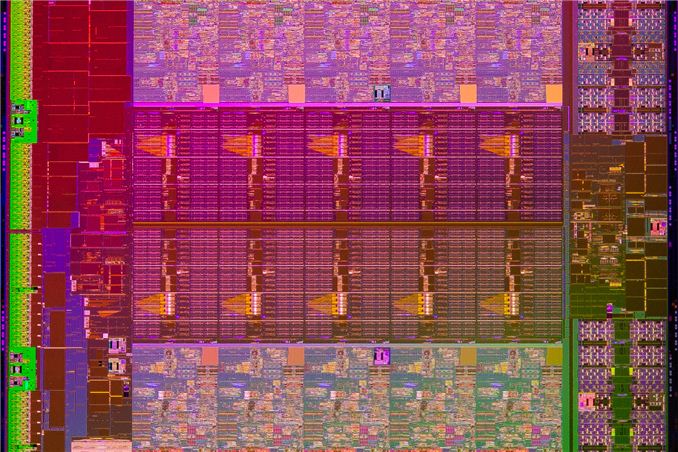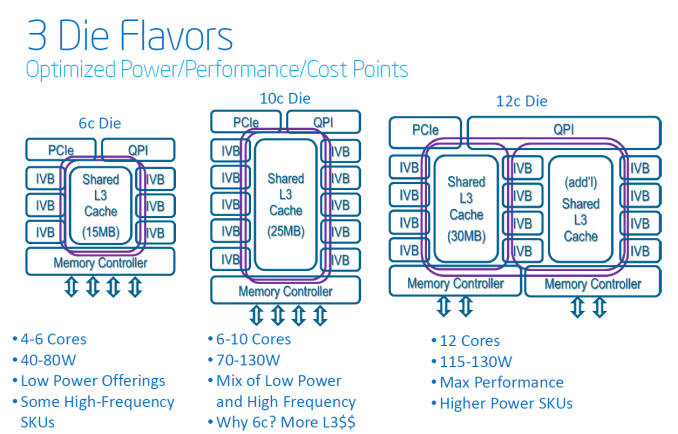Intel's Xeon E5-2600 V2: 12-core Ivy Bridge EP for Servers
by Johan De Gelas on September 17, 2013 12:00 AM EST
The core architecture inside the latest Xeon is typically a step behind what you find inside the latest desktop and notebook chips. A longer and more thorough validation is one reason, but there is more. The high-end model of the Xeon E5-2600 V2 or "Ivy Bridge EP" is, aside from the core architecture, completely different from the Ivy-bridge "i7 \-3xxx" that was launched in the spring of last year. With up to twelve cores, two integrated memory controllers, no GPU and 30MB L3 cache, it is the big brother of the recently reviewed Ivy-bridge E (Core i7-4960X). Intel has three die flavors of the Ivy-bridge EP:
The first one is the one with the lowest core count (4/6 cores), which is found in SKUs targeted at the workstation and enthusiast market (high frequencies) or low power SKUs; this is the core being used in the enthusiast Ivy Bridge-E processors. The second one is targeted at the typical server environment with higher core counts (6 to 10 cores) and a larger L3 cache (25MB). The third and last one is the high performance HPC and server die, with 12 cores, two memory controllers for lower memory latency, and 30MB of L3 cache.
The cool thing about the newest Xeon E5 processors is that they run on the same Romley EP platform as LGA-2011 chips. This should save the OEMs a lot of time and money, and hopefully these savings will trickled down to the customers. Let's see how Intel's latest server update performs, and if it manages to impress more than the enthusiast Ivy Bridge-E.











70 Comments
View All Comments
Bytales - Tuesday, September 17, 2013 - link
Please make some gaming related tests. Im planning on upgrading from 2x2609 to 2x2690v2, now that i now for sure that 10 cores 25 mb cache is a complete die. I dont trust verz much the design on the 12 core die, its not how i would design the CPU. Besides the 2690v2 is 3ghz base and 3.6 boost, perfect for gaming.Would have like to see how a 2690v2 would compare with a 2687w v2 in gaming related tests, seeing as the latter has a 3.4 base 4 ghz boost but 2 cores less.
Anyways, im not pazing 3000+ euros on disabled die (like the one in 2687v2) so the 10 core is my choice, but still would have like to seee how higher freq lower core count would impact gaming performance !
mking21 - Wednesday, September 18, 2013 - link
I can tell you now that the 8 core is going to kick the 10 core's ass for gaming. The higher clock will win here. So as you are going to pay 3000 euros you may as well get the best, even if it does have two cores disabled. But I do agree for me a more interesting comparison would have been 12 vs 10 vs 8 all V2s all fastest clock available versions...mapesdhs - Wednesday, September 18, 2013 - link
IMO for gaming you'd be better off with a used oc'd 2700K. I just bought one for 160 UKP,
fitted with a used TRUE (cost 15), two new Coolermaster Blademaster fans, Q-fan active
(ASUS M4E mbd, used, cost 130), runs at 5GHz no problem, silent running when idle. See:
http://valid.canardpc.com/a64s8p
The vast majority of games gain the most from a sensible middle ground between
multiple cores and a high clock. Few will properly exploit more than 4 cores with HT.
Using a multi-core XEON for gaming is silly. You would see far greater gaming
performance by getting a much cheaper 4/6-core and spending the saved cash on
more powerful GPUs like two 780 or Titans SLI, or two 7970 CF, etc. A 4-core Z68
should be just fine, though if you do want oodles of PCIe lanes for high-end SLI/CF
then I'd get X79 and a 3930K (don't see the point of IB-E).
Trust me, a 5GHz 2700K, or a 4.7GHz 3930K, paired with two much better GPUs
via the saved money, will be massively better for gaming vs. what you could afford
having spent thousands on two 10 or 12-core CPUs with much lower clocks. Most
2600Ks will oc pretty nicely too.
Bytales, what GPU(s) do you have in your system atm?
Ian.
PS. IB/HW are a waste of time. They don't oc aswell as SB. I bought a 2500K for 125, only
took 3 mins to get it running 4.7 stable on a used Gigabyte Z68 board (which cost a mere 35).
Bytales - Saturday, September 21, 2013 - link
The reason im looking at xeons is because of the motherboard i own, which is the z9ped8ws, which i bought because i need the pci express lanes two xeons provide. No other motherboard could have gottwn me what this one does, and i have looked everywhere. Thats the reason i need these xeons. I originally bought two 2609 cpus and a crossfire tahiti le(one burned down due to bitcoin mining) their purpose were/are to make the pc usable until the new xeons and the new radeons wil become available. I know i wont be getting the best possible cpus for gaming on this platform. I just want some decent performers. The 2609 i have now are 2.4 ghz no boost no HT, and did their job good so far. Im expecting decent gaming performance out of a 3ghz chip with multiple cores. Sure, i could get the 2687wv2 for the same price, but i have a hate for disabled things. Why the hell didnt they make a 10 core chip with 25 mb cache 3.5 base 4ghz boost and 150 160 w tdp. I would have bought such a cpu. But as it is ill have to make due with two 2690. Maybe, just maybe, if i see some gaming benchmarks between the two cpus, i will consider the 2687wv2. Untill then, my first choice is the 2690.Hopefully, the people from anandtwch will test this aspect of the cpus, gaming that is, becauae all they tested was server/enterpriae stuff, which was to be expected after all.
Gaming was not what these cpus were built for. But i like having strong cpus which will have my back if i decie to do some other stuff as well. I do bunch of converting, compressing, autocad photoshop. Etc. Thats why more cores. The better.
Ktracho - Thursday, October 3, 2013 - link
I would think you can get the PCIe lanes you want with a motherboard that has a PLX bridge chip, such as the ASUS P9X79-E WS, without needing to resort to a two-socket motherboard. As far as gaming, I think the E5-1620 v2 gives good bang for the money, and if you need more cores, the E5-1650 v2 does well, too. If you need a little better performance, you can get the E5-1680 v2, but at a price. Too bad Intel doesn't sell single-socket CPU versions with more than 6 cores, though.MrSpadge - Tuesday, September 17, 2013 - link
The Xeon2660v2 could in theory be what Ivy-E should have been for enthusiasts: something at least a bit more worth spending big $ on. The mainboard would have to let us enable multi-core turbo and OC the bus though.psyq321 - Tuesday, September 17, 2013 - link
Situation with IvyBridge EP is absolutely the same as with Sandy Bridge EP:- No BCLK "straps" (or ratios) for Xeon line - only 100 MHz allowed
- No unlocked multipliers
- BCLK overclocking works - your mileage may vary. I can get up to 105 MHz with dual Xeon 2697 v2 setup on Z9PE D8 WS
So, Ivy Bridge EP Xeons do not overclock particularly well - the best you can get out of 2S parts (26xx v2) is 100-150 MHz depending on the max. turbo multiplier your SKU has.
ezekiel68 - Wednesday, September 18, 2013 - link
Johan, what do you mean by "...over four NUMA nodes" in the last sentence on the Compression And Decompression page?My understanding is that for both Opeteron and Xeon, a NUMA node is a complete CPU package (with all its cores) and the associated RAM directly connected to that CPU's memory controllers. In the charts, all of the Opterons are listed as "2x Opteron XXXX". Are you considering each die within the Opteron MCM package to be a separate NUMA node -- or how else are you coming up with "four" above?
JohanAnandtech - Friday, September 20, 2013 - link
AFAIK, the two dies in the package communicate via hypertransport links and it is quicker for one die to communicate with its own memory than with the memory attached to the second die.ddkeenan - Wednesday, September 18, 2013 - link
The data in this article is incomplete. The JVM tuning used is targeted for throughput alone, basically ignoring GC pause times. The critical jOPS metric is intended to measure with response time constraints, and the results posted here are most likely highly variable and definitely dreadfully low because of the poor tuning choices.Actual customers care more about response time/latency these days. Throughput is often solved by scaling horizontally, response time is not. Commercial benchmarking should try to reflect that desire by focusing on response time and the SPECjbb2013 critical jOPS in order to influence hardware and software vendors to compete.
Finally, to Kevin G, I think it's also likely that SPARC T-series systems have been focusing on customer metrics more than competitive benchmarks, and now there's a benchmark that takes response time into consideration.